Ultraviolet communication technique and its application
2021-08-26LiangGuoYananGuoJunxiWangandTongboWei
Liang Guo, Yanan Guo, Junxi Wang, and Tongbo Wei,
1Research and Development Center for Semiconductor Lighting Technology, Institute of Semiconductors, Chinese Academy of Sciences,Beijing 100083, China
2Center of Materials Science and Optoelectronics Engineering, University of Chinese Academy of Sciences, Beijing 100049, China
3Beijing Engineering Research Center for the 3rd Generation Semiconductor Materials and Application, Beijing 100083, China
Abstract: With recent developments of deep ultraviolet (DUV) light-emitting diodes and solar-blind detectors, UV communication (UVC) shows great potential in replacing traditional wireless communication in more and more scenarios.Based on the atmospheric scattering of UV radiation, UVC has gained considerable attention due to its non-line-of-sight ability, omnidirectional communication links and low background noise.These advantages make UVC an ideal option for covert secure communication, especially for military communication.In this review, we present the history and working principle of UVC with a special focus on its light sources and detectors.Comprehensive comparison and application of its light sources and detectors are provided to the best of our knowledge.We further discuss the future application and outlook of UVC.Hopefully, this review will offer valuable insights into the future development of UVC.
Key words: ultraviolet communication; non-line-of-sight; optical wireless communication
1.Introduction
Optical wireless communication (OWC) has been a research hot spot for decades[1].From ultraviolet (UV) light to infrared (IR) light, OWC has been extensively studied.As the most popular optical communication technology, visible light communication (VLC) has received worldwide attention due to its over 10 Gb/s data rate and lower than 3.8 × 10–3bit-errorrate (BER), which shows great potential in indoor high-speed communication[2].The development of VLC has largely benefited from the development of light sources, especially visible light-emitting diodes (LEDs) technology.With the recent development of deep ultraviolet (DUV) LEDs and solar-blind detectors, ultraviolet communication (UVC) is drawing more and more attention too.
As a novel communication technique, UVC utilizes UV radiation to transmit signals which can be scattered and reflected by the particles and aerosols floating in the air.Its transmission range can be extended up to several kilometers regardless of the topographic features on the ground.Compared to traditional wireless communication, UVC has several unique features that render it a promising communication technique for future applications.Traditional wireless communication demands an obstacle-free communication channel between transceivers, while UVC can easily bypass these obstacles through scattering and reflection.The UV radiation employed in communication is also called solar-blind radiation which is located between 200–280 nm in the DUV spectrum.Most solar-blind radiation is absorbed by ozone and oxygen when passing through the atmosphere, which leaves a low background-noise communication channel near the ground[3].Furthermore, the power of DUV radiation drops exponentially with the transmission distance, which limits its propagation and makes it an ideal option for short-range communication.In radio-silent scenarios, UVC can work as an alternative to conventional wireless communication.Fig.1 shows an example of UVC system and network[4].Recently,Alkhazragiet al.demonstrated a UVC system with a recordbreaking data rate of 2.4 Gb/s.The proposed system was based on 279 nm LED and Si-based avalanche photodiode(APD), signaling that UVC has great potential in replacing traditional wireless communication in more and more scenarios.
In this article, we summarize and describe the history and working principle of UVC.A comprehensive comparison of its light sources and detectors is provided to the best of our knowledge.Then we discuss the research progress of UVC from a device perspective.For light sources, our review is based on three of the most used UV light sources including a gas discharge lamp, laser and LED.For detectors, other than the commonly-used detectors including photomultiplier tubes (PMTs) and semiconductor photodetectors (PDs), we also discuss some potential solar-blind detectors for UVC.Finally, we present the application and outlook of UVC.Hopefully, this review will offer valuable insights into the future development of UVC.
2.Development history of UVC
UVC was first put forward in the 1930s.Hulburt from the Naval Research Laboratory summarized their work from 1926 to 1933 in a report called “Signaling and Detection with Ultra-Violet and Infra-Red Radiation”[5].They employed a 3 kW,3 inch carbon arc searchlight equipped with a UV filter as light sources and a telescope with a fluorescent screen as detectors.The searchlight and telescope were accurately pointed towards each other to maximize the detection efficiency.They achieved a maximum transmission distance of 6 miles,but the communication system worked only at night.In 1945,White from University of California, Berkeley built a UVC prototype that achieved a maximum transmission distance of 3 miles, using a gallium arc lamp mounted on a 6-inch-diameter reflector as light sources, phosphor telescope and photomultiplier tube as detectors[6].Sunsteinet al.also systematically investigated the long-range UVC link in 1968[7].A xenon flash tube and photomultiplier were used as the transmitter and receiver.

Fig.1.(Color online) An example of UVC system and network[4].
In 1994, Charleset al.first proposed solid-state lasers as the light sources for UVC.A compact quadrupled Nd:YAG laser was used to prove the feasibility[8].The development of DUV LED promoted its application in UVC[3].A source array composed of 240 research-graded 275 nm DUV LEDs with a total output power of 4.5 mW was used in UVC by Shawet al.[9].They achieved a 200 b/s link for node separations of up to 100 m.
The US Defense Advanced Research Projects Agency(DARPA) launched two programs involving developing novel light sources and detectors for future military use in 2002 and 2007: the Semiconductor UV Optical Source (SUVOS)program and the Deep Ultraviolet Avalanche Photodiode(DUVAP) program.These two programs sponsored numerous pieces of research on DUV light sources and solar-blind detectors, which further boosted the development of UVC based on DUV light sources and solar-blind detectors.In 2006, a 24-unit array LED with wavelength of 274 nm and output power of 40 mW was demonstrated by Shawet al.[10].They achieved a 2.4 Kb/s mixed-excitation linear predictive(MELP) vocoder link in full sunlight at a range of 11 m.Xuet al.and his team from the University of California (Riverside)conducted a series of experiments on system performance analysis, scattering model, modulate scheme and network communication since 2007.The research papers were also published continuously[4,11−13].
UVC research in China was first started by the Beijing Institute of Technology in the 1990s[14].Ni and his group built a short-distance voice communication UVC prototype using a low-pressure mercury lamp as the light source, and a PMT as the receiver[15].In 2007, Tanget al.put forward a single scatter model that can effectively budget and evaluate the transmission distance of the non-line-of-sight (NLOS) UVC system in the solar-blind range.The model was successfully verified by the experiment results[16].They further extended the application of this model to the evaluation of signal-noise ratio(SNR) and BER[17].
In 2009, researchers from Ben Gurion University in Israel developed an underwater UVC system based on 250 nm LED[18].The system showed excellent communication performance.When transmission distance was over 170 m, the BER was lower than 10–4and the data rate was 100 Mb/s.Researchers from Greece University conducted a series of experiments on path losses in the UVC system under different distances, elevation angles, and atmospheric conditions[19].
The National University of Defense Technology began the study on UVC in 2000.Jiaet al.conducted several experiments on the scatter propagation model of the UV light based on the Monte Carlo method[20,21].They did extensive research on the influencing factors on the transmission range,data speed, and propagation characteristics of NLOS UVC links since 2011[22−25].
UVC research in Beijing University of Posts and Telecommunications started in 2010.Zuoet al.studied path loss in a novel single-scatter model based on Monte Carlo simulation[26].They extended their research to propagation models under atmospheric turbulence in 2013[27,28].Guoet al.studied the spatial-division technology and the diversity reception algorithms in a UVC system[29].In the same year, Menget al.also demonstrated applied diversity reception technology to a real-time NLOS UVC system based on a 9.3 mW LED array[30].The BER during the turbulence of the NLOS UVC system with On-Off Keying (OOK) modulation and Maximum Likelihood (ML) detection was analyzed and compared with that in free space without turbulence.In 2018, Sunet al.used a 266 nm DUV LED array with 50 mW luminous power as the light source achieving a high data rate of 921.6 Kb/s and BER of less than 10–7in 150 m, which can beat the best record created by DUV LED communication system in terms of the data rate[31].
Studies at King Abdullah University of Science & Technology mainly focused on underwater UVC.Research based on laser and LED have been published successively[32,33].In 2018, Heet al.from the University of Strathclyde in the UK achieved a record-high data rate of 1 Gb/s with 262 nm micro-LED[34].The bandwidth of the light sources was 438 MHz at a current density of 71 A/cm2when saturating.In the same year, Kojimaet al.from Tohoku University in Japan reported a 1.6 Gb/s error-free transmission over a 1.5 m line-of-sight(LOS) link in direct sunlight with a 280 nm LED[35].
3.Working principle of UVC
3.1.Configuration of UVC
A typical configuration of UVC is shown in Fig.2.The transmitter side consists of the signal generator, current sources,modulation circuits and light sources such as DUV LEDs, DUV lasers, or mercury lamps.The electrical signals from the signal generator are coded by a modulation circuit and converted into high-frequency currents.Then high-frequency currents are amplified by current sources and supplied to light sources to generate light signals.
The receiver side consists of a solar-blind filter, UV detectors (usually PMT, p–i–n photodiode (PIN), or avalanche photodiode (APD)), signal amplifier, demodulator and so on.Thelight signal detected by the UV detector will be converted back into the electrical signal.In order to increase the SNR, a signal amplifier is required to increase signal power.After demodulation and reconstruction, the signal will be restored.
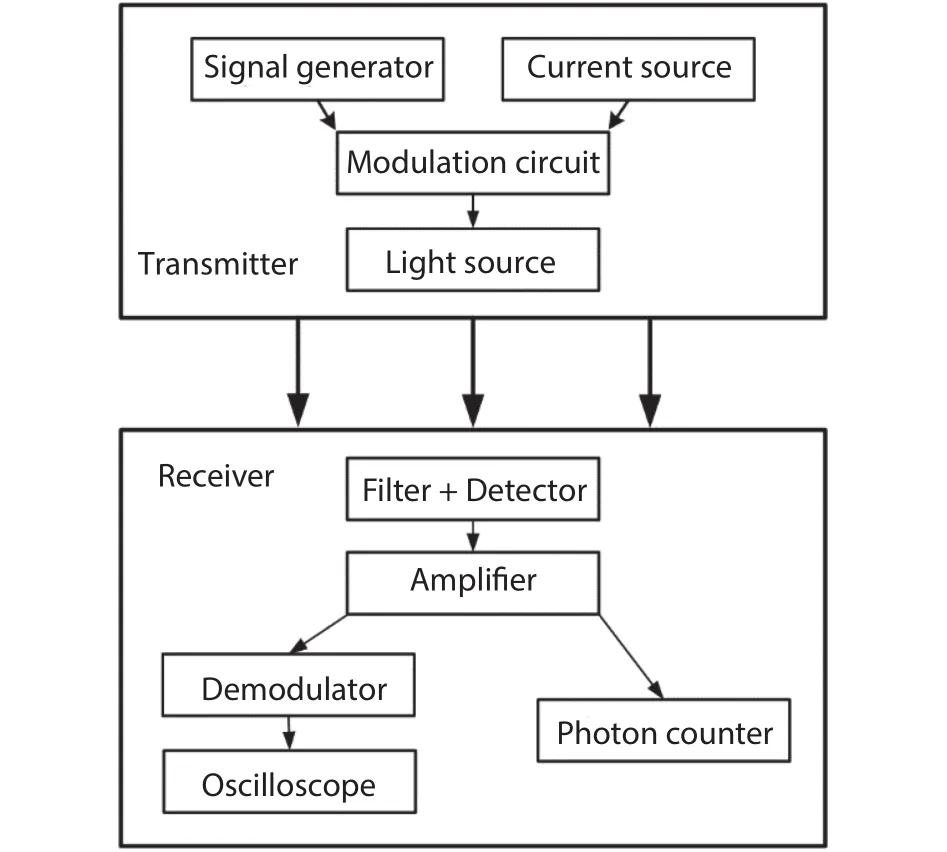
Fig.2.The typical configuration of UVC.
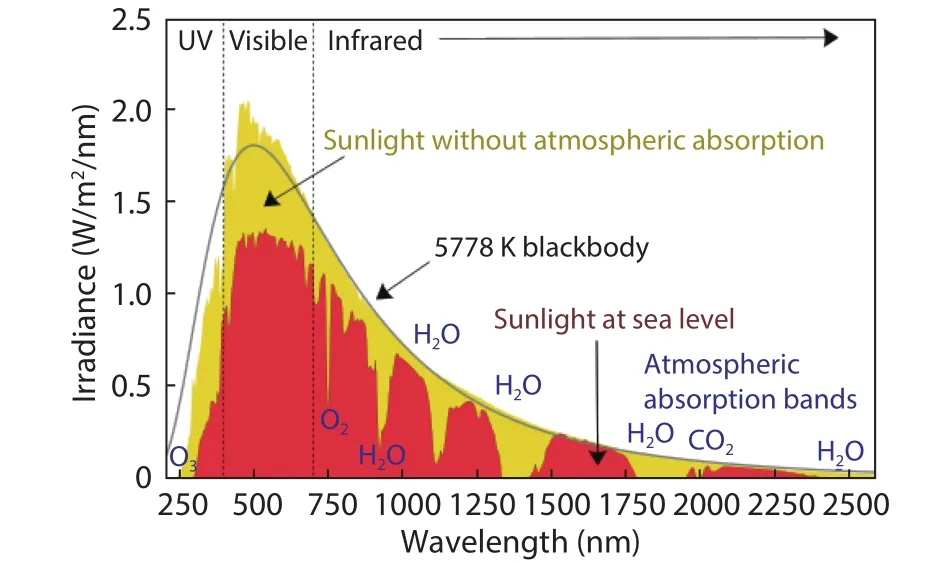
Fig.3.(Color online) The spectrum of solar radiation on earth[37].
3.2.Atmosphere propagation
When passing through the atmosphere, solar radiation is strongly scattered, absorbed, or reflected by the water vapor,carbon dioxide, fine particles, oxygen, ozone and other gas molecules in the air, causing discontinuities in the solar spectrum.Of all the molecules and particles, ozone which accounts for only 0.01%–0.1% of the atmosphere has a strong absorption band in the UV spectrum[36].The UV part of solar radiation near the ground consists of about 95% UV-A and 5%UV-B; UV-C and most of UV-B are removed by stratospheric ozone.Fig.3 shows that the distribution of the solar radiation spectrum near the ground.
Atmospheric scattering is the basis of NLOS UVC.When the light propagates in the atmosphere, its electromagnetic field will oscillate with the charges of particles floating in the air, which will generate one or more dipoles that radiate secondary spherical waves with the same frequency and phase as the original ones[38].Generally, the closer the size of the particles is to the wavelength of UV light, the stronger the UV light will be scattered.Two scattering models are used in the study of scattering characteristics of UV radiation according to the relationship between the particle size and the light wavelength: Rayleigh scattering model and Mie scattering model.
Assuming that the intensity of monochromatic light radiation isI, the absorption caused by atmospheric scattering and absorption obeys the Lambert–Beer law[39]:

I0is the luminous flux before absorption,Iis the luminous flux after absorption,lis the transmission distance andμ(λ)is the light’s atmospheric attenuation coefficient of the wavelength ofλper distance unit.Atmospheric attenuation coefficient can be derived from the following expression:

αa(λ),αm(λ) represent the absorption coefficient of the atmospheric aerosols and atmospheric molecule,βa(λ) andβm(λ)represent the scattering coefficient of the atmospheric aerosols and atmospheric molecule.
3.3.Channel model
UVC has two channel models: LOS model and NLOS model.The pointing angles of the transmitter and receiver in the LOS model require rigorous regulations to ensure that they are on the same horizontal line.The LOS model is suitable for point-to-point communication at a relatively short distance without obstacles between the transmitter side and receiver side.Path loss in the LOS model mainly derives from atmosphere absorption and scattering.
The LOS model is shown in Fig.4(a).TXrepresents the transmitter side,RXrepresents the receiver side,Φ1is the transmitter’s beam divergence angle andΦ2is the receiver’s fieldof-view (FOV).Assuming the transmitted power isPt,represents the transmitted power after a transmission distance ofr1.According to the Lambert–Beer law, after transmission distance ofr2, transmitted power further drops to
The received power is:

According to the geometric relationship in Fig.4(a),

The received power can be further simplified into:

Fig.4.Typical channel models of UVC: (a) LOS model, (b) NLOS model.
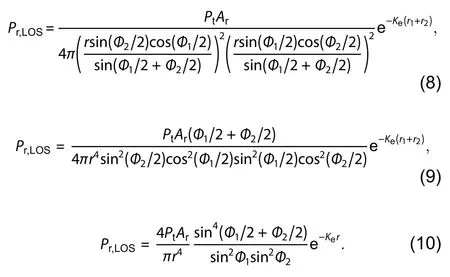
According to Eq.(10), the received power is affected by the transmission distancer, the divergence angle of the light sourceΦ1and the reception angle of the detectorΦ2, the atmospheric attenuation coefficientand the reception gain of the detector.It can be seen that transmitted power drops exponentially with transmission distance in the LOS model,making UVC unfit for long-range communication.
In the NLOS model, the beam divergence angle of the transmitter and the FOV of the receiver are not directly pointing at each other.There are obstacles between the transmitter and receiver.In this case, the light signal can be received by detectors after multiple atmospheric scattering.A diagram of the NLOS model is shown in Fig.4(b).Φ1is the transmitter’s beam divergence angle,Φ2is the receiver’s field-ofview (FOV),θ1andθ2are the elevation angle of transmitter and receiver.Assuming thatPtis transmitted power,is the transmitted power per unit of stereo angle,is the transmitted power after a transmission distance ofr1.Assuming the overlap betweenr1andr2is a secondary source composed of a large number of particles, and the output power of the secondary source isThe secondary source and receiver can be seen as a LOS model.The received power is expressed as:


The final received power of the NLOS model can be simplified as

ris the distance between transmitter and receiver,is the extinction coefficient,Ke=Ks+Ka,Ksis the scattering coefficient,Kais the absorption coefficient.λis the wavelength of ultraviolet light,Aris the receiver aperture area,Ω1is the transmitter’s stereo angle,Vis the effective scattering volume,andPsis the phase function of scattering angle ofθs.A more detailed deduction can be found in Ref.[40].
3.4.Modulation
In UVC, light signals can be easily interfered by the background light noise during the propagation.Signals need to be superimposed on light waves which act as carrier waves to improve the stability and reliability of UVC.The intensity, frequency, phase, polarization of the carrier waves are modulated by the signals.The light signals that reach the photodetector will be demodulated to restore the original signal after opto-electrical (O-E) conversion.
Some of the most prevailing modulation schemes include OOK, pulse position modulation (PPM), fixed-length digital pulse interval modulation (FDPIM) and digital pulse interval modulation (DPIM).Different modulation schemes vary in terms of power utilization rate, frequency band utilization rate, channel capacity and inter-symbol interference.As the most used intensity modulation / direct detection (IM/DD)modulation scheme, OOK has the highest frequency band utilization rate and lowest inter-symbol interference, but its power utilization rate is the lowest among these four modulation schemes.Besides, OOK is easy to implement with no complex modulator circuits required.PPM has the highest frequency band utilization rate, making it suitable for longrange and high background noise UVC systems.
4.Light sources of UVC
UV light source is one of the most critical components of the UVC system.Its optical power essentially determines trans-mission distance of UVC, while its bandwidth has a major impact on the data rate.As for the wavelength, shorterwavelength signal will be less affected by the background noise, enabling a higher SNR for UVC.Gas discharge lamps,lasers and LEDs are the three most used light sources in the UVC system.Gas discharge lamps have great advantages in cost and output power.However, lasers excel in their high coherence, high monochromaticity and low divergence.They both share the same deficiency of heavy volume, large power consumption and low modulation rate.AlGaN-based LED has gained more and more attention in UVC due to its higher modulation rate and smaller chip size.By packaging multiple LED chips into one source array, its output power can reach up to Watt range.When reducing its size to the micrometer range,its bandwidth can reach up to GHz level[34].A detailed comparison of DUV light sources in the UVC system is shown in Table 1.
4.1.DUV gas discharge lamp
As the first-used light source, the gas discharge lamp has a long history in UVC.Some of the most used UV gas discharge lamps include high and low-pressure mercury lamps,UV halide lamps and mercury xenon lamps.The conversion efficiency of the low-pressure mercury lamp can reach up to 30%–40%.In 1976, hydrogen-xenon arc lamps with high pulse repetition rates were used in the investigation of ultraviolet voice communication by Fishburneet al.[46].They did a variety of communication tests during daylight hours, early evening hours and thunderstorms.High-quality voice communication is reported regardless of weather or time of day.Myer Geller and GB Johnson of Naval Ocean Systems Centre used two 25 W mercury discharge lamps filled with argon gas as light sources, achieving 2.4 Kb/s of data rate in both LOS and NLOS modes[47].Under the average ozone concentration,the maximum transmission distance in LOS mode can reach 3 km, and the transmission distance in NLOS can reach 1 km.In 1990, Puschellet al.used mercury arc lamps with a modulation rate of 40 kHz and a peak wavelength of 265 nm as sources, achieved a high data rate (1.2 Mb/s) within the range of over 7 km[48].
4.2.DUV laser
Although gas discharge lamps have great advantages in output power, it still suffers from fragility and short lifetime.People begin to turn to other solar-blind sources like DUV laser.In 2010, an experimental test-bed using a narrowpulsed ultraviolet (UV) laser was set up to characterize pulse broadening effects in short-range NLOS UVC channels by Chenet al.[49].Wanget al.built a real-time UVC system using a 200 mW solid-state 266 nm laser as the light source in 2017[50].A data rate of 400 Kb/s was measured with a frame error rate lower than 10−5.Liaoet al.experimentally and theoretically investigated long-distance NLOS UVC channel using a compact Q-switched fourth-harmonic neodymium-doped yttrium aluminum garnet (ND:YAG) 266 nm laser[51].Sunet al.demonstrated an NLOS Underwater wireless optical communication (UWOC) link using a UV 375 nm laser diode[32,33].The schematic of the experimental setup for UV laser-based NLOS UWOC is shown in Fig.5.
4.3.DUV LED
4.3.1.Introduction to DUV LED
As a pollution-free, low cost and high-efficiency optoelectronic device, AlGaN-based LEDs are replacing conventional mercury lamps as DUV light sources in many applications like sterilization, curing and medical diagnostics[52−55].With recent advancements in DUV LEDs, the data rate and transmission range of LED-based UVC have reached an unprecedented level.More and more research groups have chosen DUV LEDs over DUV lasers or DUV gas lamps as the light sources for UVC due to its higher modulation rate and smaller chip size.However, AlGaN-based LEDs still suffer from relatively low output power and low quantum efficiency due to the high aluminum content[56].The higher aluminum content theoretically enables a shorter emission wavelength, while also degrading the crystal quality due to the large thermal and lattice mismatch between substrate and epilayer.The increase of aluminum concentration will further enhance the activation energy of Mg in p-type AlGaN, which makes it challenging to obtain high hole concentration[56−58].
As the most ideal light source for UVC, the emission wavelength of AlGaN-based LEDs can be tuned from 210 to 360 nm which covers the entire solar-blind spectrum.Besides, LEDs exceed other light sources in bandwidth and response speed as well, facilitating its application in optical communication[59].Table 2 summarizes the recent progress in UVC using DUV LEDs as the light source.
Sunet al.demonstrated a UVB-LED-based communication channel with a high data rate of 71 Mb/s.The proposed LED had an output power of 190μW at 7 V bias voltage,wavelength of 294 nm and a –3 dB bandwidth of 29 MHz, as plotted in Figs.6(a) and 6(b)[64].In 2020, Omaret al.demonstrated a record-breaking data rate of 2.4 Gb/s at a distance of 1 m using a 279 nm LED with bandwidth of 170 MHz[60].The experiment setup and the modulation bandwidth of the system are shown in Figs.6(c) and 6(d).Yanget al.reported a solar-blind UV LED real-time video transmission system using a 265 nm LED as the source.The experimental results showed that the maximum data rate is 2.88 Mb/s and when the transmission distance was 4 m, the data rate can be up to 1.92 Mb/s.Sunet al.proposed and demonstrated a high data rate UVC system based on a 266 nm UV LED array with 50 mW luminous power[31].The emitting source was driven by a three outputs constant-current control circuit, whose driving speed was up to 2 Mb/s.
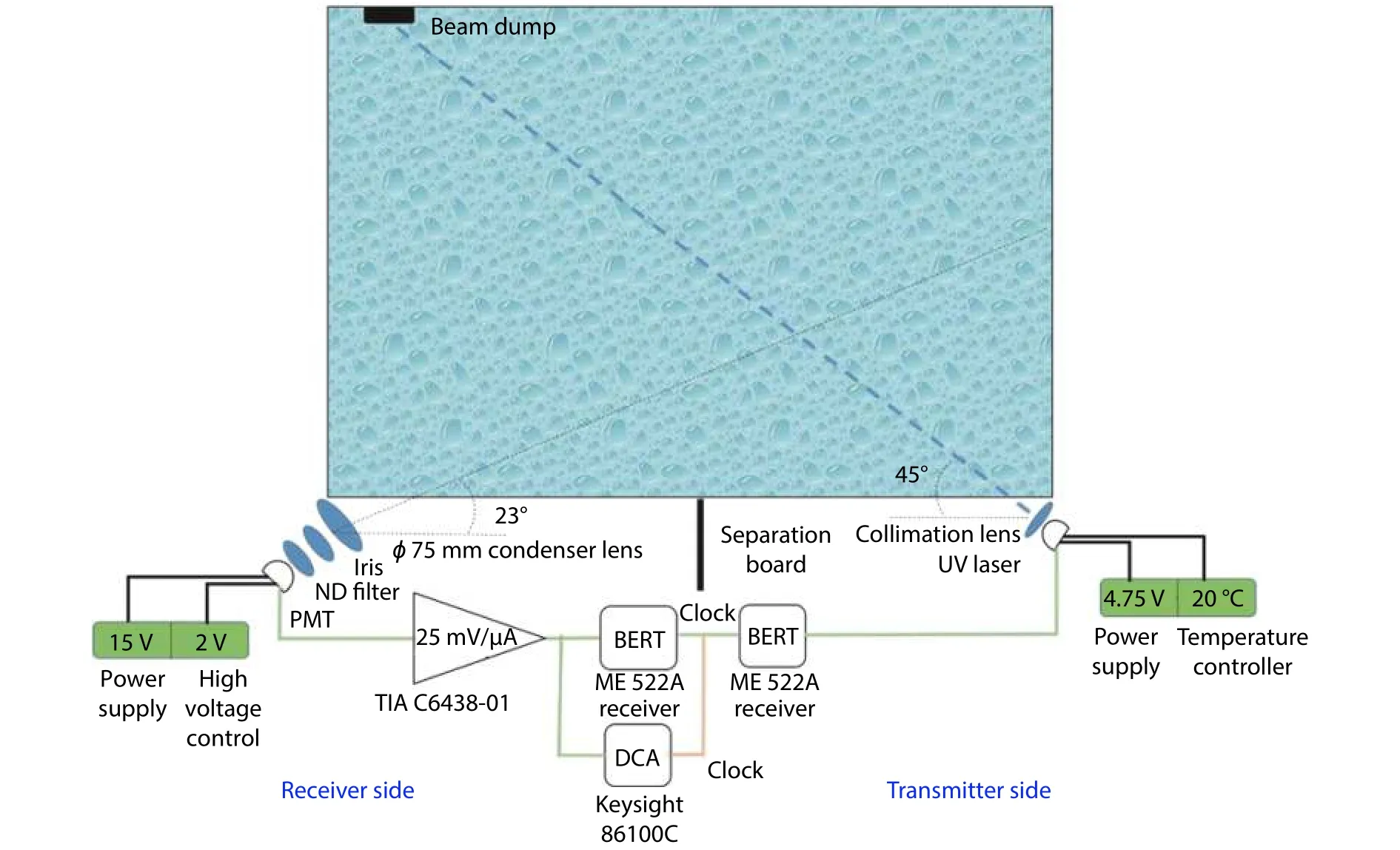
Fig.5.(Color online) The schematic of the experimental setup for UV laser-based NLOS UWOC[33].
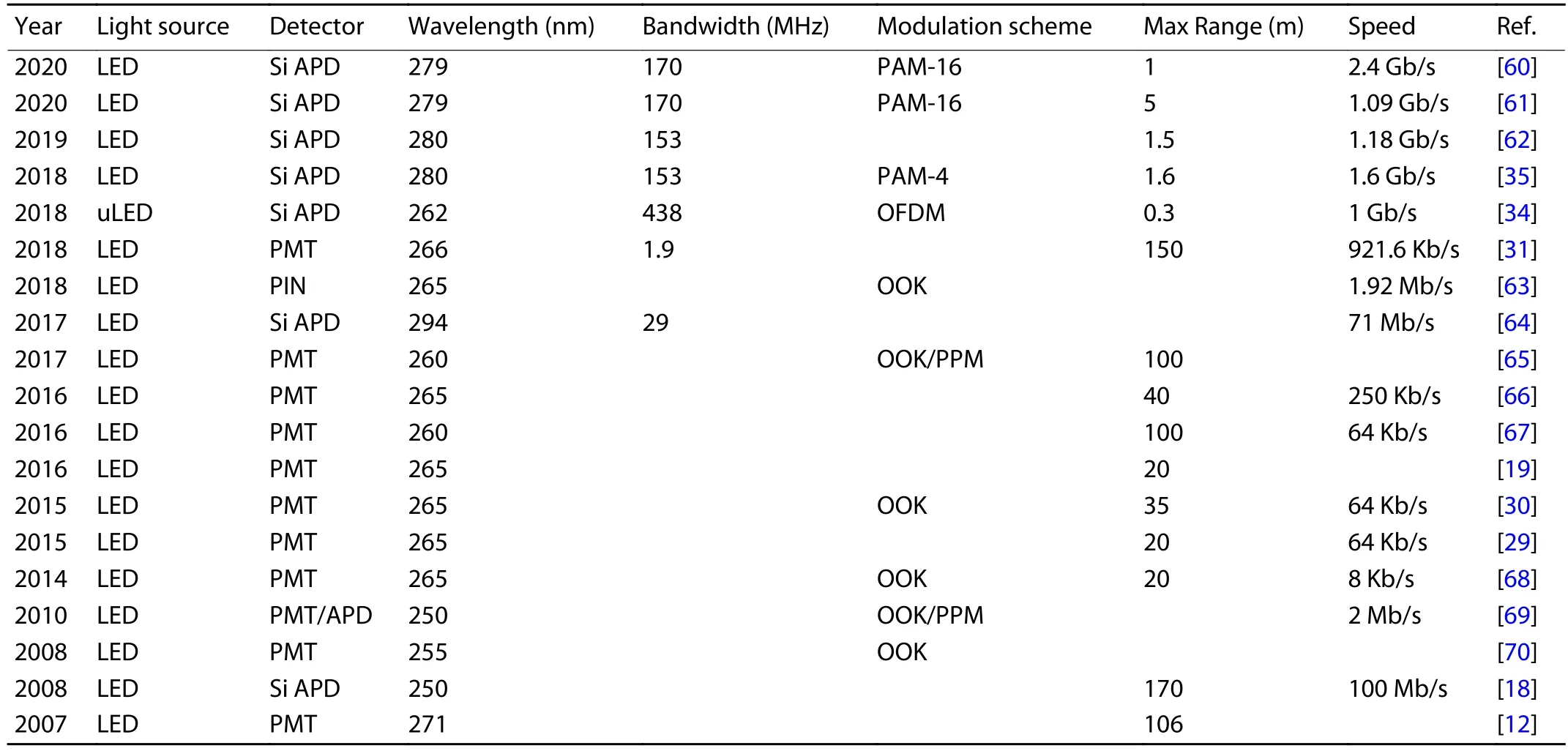
Table 2.Recent progress in UVC using LED as the light source.
4.3.2.Approaches to improve DUV LED bandwidth
Generally, the bandwidth of LEDs is affected by two factors: RC time constant[71,72]and carrier lifetime[73,74].The RC time constant is determined by the device’s resistance and capacitance, both of which can be tuned by the device size.Devices with larger sizes have lower bandwidth under the same current density.This is due to the reason that the increase in capacitance has a more significant impact on bandwidth than the decrease in resistance.By increasing carrier concentration, the radiative recombination rate will increase too,which leads to shorter carrier lifetime and more photons generating in the unit time.The bandwidth of LEDs eventually depends on the trade-off between these two factors.For conventional size LED under small current density, DUV LED bandwidth is dominated by carrier lifetime.As the current density increases, the carrier density in the multiple quantum wells(MQWs) increases too, leading to a shorter lifetime.As shown in Fig.7(a), the modulation bandwidth at 40 mA is roughly threefold that of 20 mA[75].But when the current density increases to a certain level, the carrier lifetime of DUV LED will saturate.Then RC time will have a major impact on the further decrease of carrier lifetime[76].
As a recent research hotspot, micro-LED shows great potential in high-speed optical communication[74,77,78].Itsdevice size can be reduced to as small as 3.6μm[79], and its bandwidth can reach up to 1.5 GHz[80].Moreover, smaller chip size leads to better heat distribution and uniform current injection which results in a greater than two-fold decrease in the thermal resistance of the device, as compared with the conventional size LED[81].AlGaN-based DUV micro-LED was first reported by Zhanget al.in 2003[82].Since then,a lot of effort has been devoted to improving its outputpower and external quantum efficiency (EQE)[82−88].In 2019, researchers from the UK first proposed 262 nm micro-LED as the light source for UVC[34].Simplified cross-sectional schematic of a single DUV micro-LED and plan view optical image of the fabricated DUVμLED array were shown in Figs.7(b) and 7(c).The measured 3 dB modulation bandwidth of theseμLEDs initially increased linearly with the driving current density and then saturated as 438 MHz at a current density of 71 A/cm2as shown in Fig.7(d), which was limited by the cutoff frequency of the commercial APD used for the measurement.
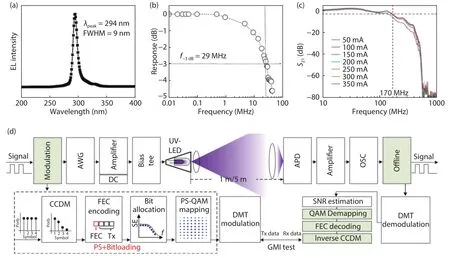
Fig.6.(Color online) (a) Optical spectra of the LED under a bias voltage of 7 V[64].(b) The small-signal frequency response of the system.The dashed line indicates the –3 dB bandwidth, which is approximately 29 MHz at distance = 0[64].(c) The modulation bandwidth of the system at a distance of 5 m with different injection currents[60].(d) The experimental setup and the flow diagram of the signal generation and offline processing[60].
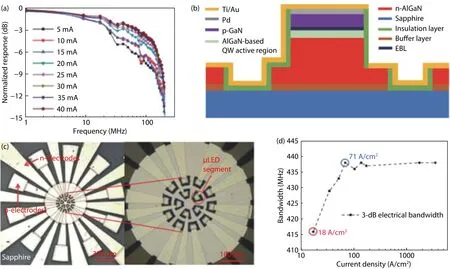
Fig.7.(Color online) (a) A 4 × 4 matrix device structure with a single device size of 60 μm, with the corresponding changes in device response frequency and current[75].(b) Simplified cross-sectional schematic of a single DUV μLED presented in this work.Dimensions are not to scale[34].(c) Plan view optical image of the fabricated DUV μLED array presented in this work[34].(d) The 3 dB electrical modulation bandwidth of the DUV μLED as a function of current density[34].

Fig.8.(a) Normalized PL decay kinetics for AlGaN MQW structures with different well widths: (1) 5 nm, (2) 4.1 nm, and (3) 2.5 nm.Measurements were performed under excitation energy density of 25 mJ/cm2[90].(b) Well-width dependence of carrier lifetimes for AlGaN MQW structures at excitation energy density of 70 μJ/cm2[90].(c) Lifetime for different temperatures derived from the TD-TRPL results[91].
Carrier lifetime can also be effectively reduced by optimizing the MQW structure.LEDs with a thinner QW show a higher carrier density in the individual QW and a smaller spatial separation of the electron and hole wave functions by quantum-confined stark effect (QCSE)[89].As the width of the quantum well increases, the radiative recombination rate and the optical power also increase.Time-resolved photoluminescence (TRPL) measurement of MQW with different well width of 2.5, 4.1 and 5 nm were depicted in Fig.8(a)[90].The carrier lifetime showed an inverse proportion to well width(Fig.8(b)).
Quantum barrier height in MQW is modulated by its aluminum composition, which will further impact the radiative recombination rate and output power of DUV LEDs[92,93].LEDs with Al mole fraction of 55%, 60%, 67% and 76% in the QB were experimentally and numerically investigated by Guttmannet al.in Ref.[94].When increasing the aluminum composition, the quantum barrier’s binding effect on electrons and holes is enhanced, and the overlap between electron and hole wave function is increased.But when further increasing the height of the potential barrier, the MQW layers will act as a barrier to hole injection from the p-type layer,making the hole concentration and carrier lifetime in the quantum well decrease.
In 2017, Tianet al.investigated the impact of Si-doped Al-GaN quantum barriers on the hole distribution in the MQWs,the radiative recombination rate and the optical powers of AlGaN DUV LED[95].Results indicated that the Si-doped quantum barriers can significantly reduce the polarization induced electric field and increase the spatial overlap between the electron and hole wave functions in DUV LEDs.The device with Si doping concentration of 1 × 1019cm–3in quantum barriers showed a three-times increase in radiative recombination rate compared to the undoped ones.
Surface plasmon (SPs) can change the optical environment of the emitter due to its near-field enhancement properties.When the LED’s MQW is coupled with SPs, a new energy conversion channel is added to the electron-hole pair.Thus,the energy of the electron-hole pair can be directly transferred to the SP, increasing the spontaneous radiative rate and reducing the carrier lifetime[91,96−98].By fabricating highdensity and uniform Al nano-particles near the MQW active region, the IQE of AlGaN DUV LED showed a 57.7% enhancement with reduced radiative recombination lifetime from 1.71 to 1.40 ns as shown in Fig.8(c)[91].
The electron blocking layer (EBL) between the p-type layer and active region in AlGaN-based LED can block the electrons overflowing from the active region and increase carrier residence time in MQW.However, EBL will also prevent the hole in the p-type layer from entering the active region.Numerical and experimental results indicate that LED with low barrier height EBL shows higher radiative recombination rate and hole injection efficiency, thereby leading to higher modulation bandwidth[99].
5.Detectors of UVC
As the most crucial components in the receiver side of UVC, detectors have a major impact on the BER and SNR of UVC.PMT is one of the most used PDs in scientific research due to their superior sensitivity and responsivity, especially in the detection of ultrashort pulse light and ultra-weak photons.Compared to the PIN and APD, PMT has a larger detection area, lower dark current and higher multiplication gains.But it is also fragile, expensive, and requires expensive solar-blind filters that fail to meet the trends of miniaturization for UVC.Besides, its bandwidth is merely 50 MHz, much lower than the commonly used Si-based detectors and SiC-base detectors.Semiconductor detectors like PINs and APDs still suffer from relatively high dark current and noise, which is about 5–6 orders of magnitude higher than PMT.APDs work under a much higher reverse bias than PDs, which increases the current gain to the order of 1000[100].A detailed comparison is shown in Table 3.
5.1.PMTs
PMT has a long history in UVC, which is also the most used detectors since UVC is first put forward.Xinget al.studied the 2 × 2 MIMO scheme for UVC using two independent PMTs as the detectors, which have a 3 dB bandwidth of 5 MHz[66].Narrowband interference UV filters are mounted on PMTs to block the ambient light as shown in Fig.9(a).Raptiset al.studied the power losses in diffuse UVC channels[19].The receiver consisted of a PMT (with a responsivity of 0.06 A/W at 265 nm).A large set of measurements at distances up to 20 m, for different elevation angles of the transmitter (UV-LEDs) and receiver (PMT) and for different atmospheric conditions have been taken for the characterization of the UVC channel in terms of path loss.The experiment setup is shown in Fig.9(b).Menget al.built up a four-receiver real-time platform and explored the characteristics and effectiveness of diversity reception in single-input-multiple-output (SIMO) UVC system with a four-PMT-detector array[30].Each pair of PMTs was transversely separated by 150 mm as shown in Fig.9(c).The experimental results for 1 × 4 SIMO UVC system showed that with a smaller Tx elevation or shorter distance, equal gain combining (EGC) may produce a diversity gain in the UV channel and thus improve the BER performance at low transmitter power.
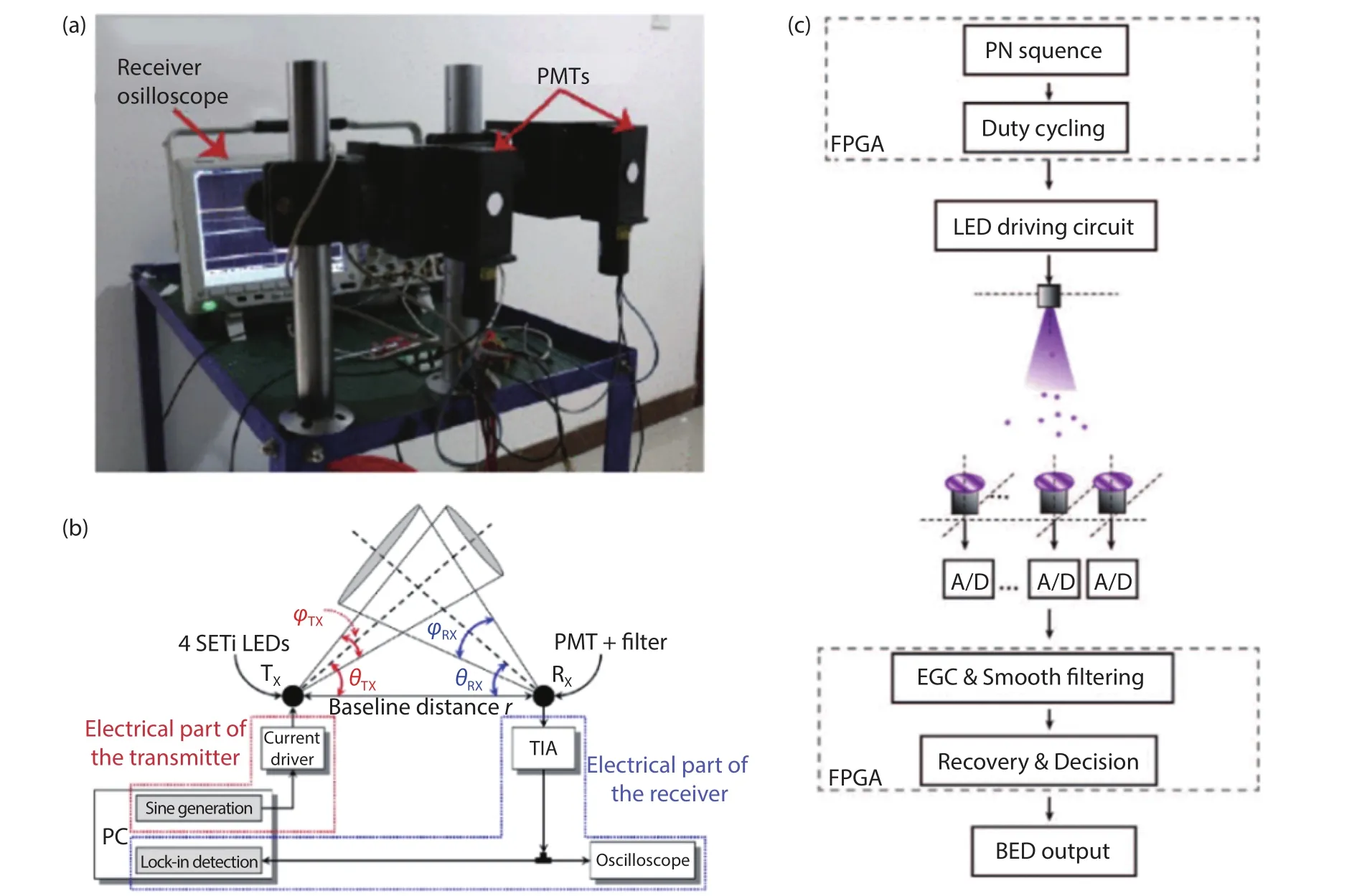
Fig.9.(Color online) (a) The experimental setup of the receiver side[66].(b) The experimental setup[19].(c) Experimental setup for solar-blind NLOS UV communication with diversity reception[30].

Table 3.Comparison of DUV detectors in UVC system.
5.2.Semiconductor PDs
Recently, the commercially available Si and SiC-based PINs and APDs have been replacing PMT in more and more scenarios.SiC-based PD shows excellent UV responsivity characteristics and a very low dark current between 200 and 400 nm.The responsivity at 270 nm is between 150 and 175 mA/W with a quantum efficiency of between 70% and 85%[103].Several groups have reported UVC links using Si APD for UV detection[34,64].The reported detector has a wavelength range of 200–1000 nm, bandwidth of 400 MHz, responsivity of 15 A/W and an active area diameter of 0.2 mm.Kojimaet al.used a 1 GHz Si-based APD with 30 kV/W responsibility at 250 nm in UVC link[35,62].
AlGaN-based APDs are intrinsically solar-blind with no additional filters required and are an ideal alternative to current bulky and fragile PMTs.In 2014, Shaoet al.reported an AlGaN-based APD with a record-high gain of 1.2 × 104and a peak responsivity of 0.15 A/W around 280 nm[104].The absorption and multiplication zone were separated by a 60 nm ntype Al0.4Ga0.6N layer and thus yielded higher gain and lower noise than the regular APD.
5.3.Potential detectors for UVC
Recently, solar-blind detectors with novel material and device structure have been proposed extensively, among which Ga2O3, ZnO-Ga2O3and MgZnO based detectors have shown great potential in replacing the current solar-blind detectors for UVC.With its wide bandgap of 4.9 eV, Ga2O3-based PDs are perfectly fit for solar-blind detection in UVC[105−107].Huet al.fabricated Au-Ga2O3-Au based solar-blind PDs which showed a maximum responsivity at around 255 nm and a cutoff wavelength of 260 nm[108].solar-blind PDs based on Ga2O3/SnO2and Ga2O3/Si heterostructures were also reported by Mahmoud and Guo in 2016[109,110].
The lattice mismatch between ZnO and Ga2O3is relatively small, making it easier to grow Ga2O3on ZnO.And the large conduction band offsets between Ga2O3and ZnO prompt large avalanche multiplication which leads to larger responsivity.Zhaoet al.proposed a single core-shell microwire APDs based on ZnO–Ga2O3heterostructure[111].The proposed APDs with peak responsivity of 1.3 × 103A/W, detectivity of 9.91 × 1014cm·Hz1/2/W and response time of 20 μs under –6 V bias exhibited excellent photo-response performances compared to commercial Si-based APDs.
MgZnO is another promising candidate for solar-blind PDs.Theoretically, the bandgap of MgZnO can be tuned from 3.4 to 7.8 eV by changing the Mg content.But the fabrication technique for MgZnO is still in its infancy due to the large mismatch between the MgZnO epilayer and its common substrates.Duet al.first proposed MgZnO-based solarblind PDs in 2009[112].Since then, more and more groups have participated in this area.In 2016, Alemaet al.achieved a record high responsivity of ~1.8 × 104A/W at 276 nm under 10 V bias for MgZnO-based solar-blind PDs[113].This is attributed to the asymmetric barrier height at the two sides of the MSM (metal–semiconductor–metal) electrodes which gave rise to the carrier trapping states at the MgZnO/Ni/Au interface.
6.Future application of UVC
UVC has a lot of potential applications in underwater communication, vehicular communication and machine-to-machine communication.The frequency band used in UVC is much higher than that of radio frequency (RF) communication, so traditional electromagnetic interference (EMI) technology and signal interception technology cannot be applied to UVC, guarenteeing confidential and interference-free communication environment for UVC.We present some scenarios where UVC can be a viable alternative to conventional communication.
6.1.Battlefield applications
On the battlefield, radio sometimes needs to be turned off to conceal operation.Under this circumstance, gestures or code words will usually be used for short-range communication.By using UVC as the alternative, unicast, multicast and broadcast communications will be possible.Short-range communication in conventional tactical operations usually requires cable, but the cable set-up requires extra time severely restraining the speed and maneuverability of operation.While UVC systems can be quickly set up with no cable required.
6.2.Aircraft guidance system
UVC can also be used in take-off guidance systems among control towers, aircraft carriers and aircraft[114].Transmitters can be mounted on the bridge of the aircraft carrier to radiate UV light signals horizontally to the deck, and each aircraft is equipped with a small receiver to collect guidance signals distributed in the air.The light signal from the transmitters can illuminate the entire flight deck so that the aircraft can move freely and receive signals simultaneously.

Fig.10.Application of UVC in aircraft squad.
6.3.Aircraft squad communication
UVC systems can be used for confidential communications among aircraft squad as shown in Fig.10.In this case,each aircraft is equipped with a transceiver system.The transmitter radiates light signals in a horizontal direction and the receiver is mounted facing the sky to collect UV signals scattered into its FOV to build electromagnetically silent and secure internal communications.
7.Conclusion and outlook of UVC
In this article, we summarize and describe the history and working principle of UVC.A comprehensive comparison of its light sources and detectors is provided to the best of our knowledge.Then we discuss the research progress of UVC from a device perspective.For light sources, our review is based on three of the most used UV light sources including gas discharge lamp, laser and LED.For detectors, other than the commonly used detectors including PMTs and semiconductor PDs, we also discuss some potential solar-blind detectors for UVC.Finally, we present the application and outlook of UVC.Hopefully, this review will offer valuable insights into the future development of UVC.
As a novel optical communication, UVC shows great potential in replacing conventional communication.Rich theory on the networking, channel model, modulation scheme and signal processing have been put forward and verified experimentally[4,115,116].However, light sources and detectors still are the two bottlenecks restricting UVC’s wide application.With high security, high stability, low power loss and short response time, AlGaN-based LEDs have been considered as one of the most ideal light sources for UVC[117,118].However,the research on its bandwidth is still in its infancy.How to improve the bandwidth of DUV LEDs in terms of material growth, device structure, manufacturing process and packaging is still an open question.PMT has gradually been replaced by its cheap and efficient counterparts like PINs and APDs in UVC.But solar-blind PINs and APDs still suffer from relatively high dark current and low responsivity.Improvement in fabrication techniques and device structures is expected to resolve these issues.
Acknowledgements
This work was financially supported by the National KeyR&D Program of China (No.2019YFA0708203), the National Natural Science Foundation of China (No.61974139), and the Beijing Natural Science Foundation (No.4182063).
杂志排行
Journal of Semiconductors的其它文章
- Polymer acceptors for all-polymer solar cells
- Ionic liquids in perovskite solar cells
- Perovskite crystallization
- Black phosphorus junctions and their electrical and optoelectronic applications
- All-polymer solar cells
- Extensive study of optical contrast between bulk and nanoscale transition metal dichalcogenide semiconductors
